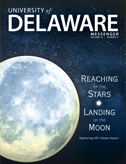From tiny things,
big ideas arise
FACULTY | Scientists have long known that a virus can infect even the smallest living things. They even know a lot about the hundreds of genes that make up those microscopic organisms.
What still puzzles them is understanding what happens once a virus gets inside. What changes do the virus cause inside the microbe, and what impact does this have on the entire microbial community?
UD researchers recently won a $6 million federal award to help answer those questions, possibly opening a pathway to advances in agriculture, better predictions of disease risk and even more-effective medicines.
Led by UD’s K. Eric Wommack, deputy dean in the College of Agriculture and Natural Resources, the study will challenge UD’s cell researchers to develop technology to study virus-microbe interactions in a droplet of water smaller than mist.
“Imagine doing a classic microbiology experiment with test tubes and culture plates,” Wommack says. “Our research would take all of those test tubes and cultures and reduce them down to a tiny droplet 100 times smaller than the diameter of a human hair.”
Additionally, UD’s Kelvin Lee, the Gore Professor of Chemical and Biomolecular Engineering, is a co-investigator on a $6.1 million research project, led by Clemson University, aimed at lowering drug manufacturing costs. Their work seeks better ways to engineer Chinese hamster ovary cells, which are used to manufacture more than half of biopharmaceuticals. Products from these cells are used in drugs to treat Crohn’s disease, severe anemia, breast cancer and multiple sclerosis, and represent more than $70 billion in sales each year. Lee, who directs the National Institute for Innovation in Manufacturing Biopharmaceuticals, said the project would help address challenges in making these medicines more widely available.




